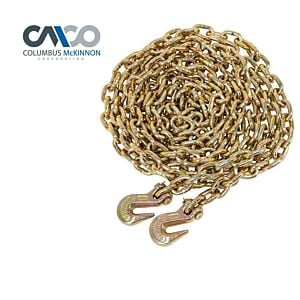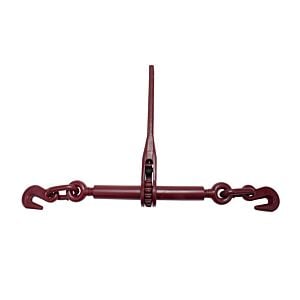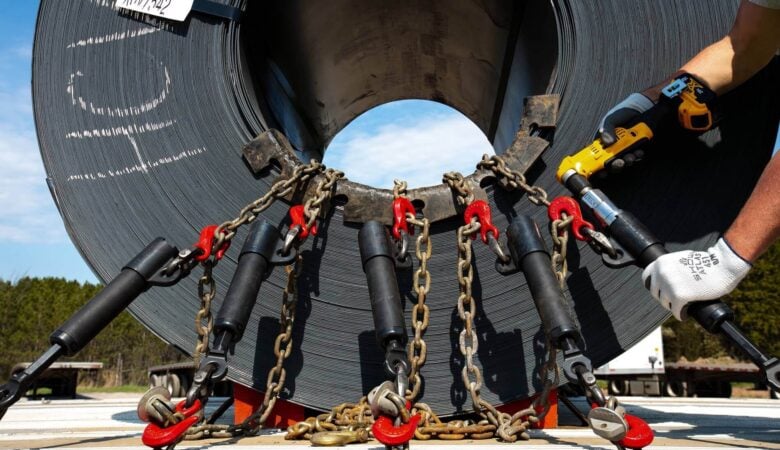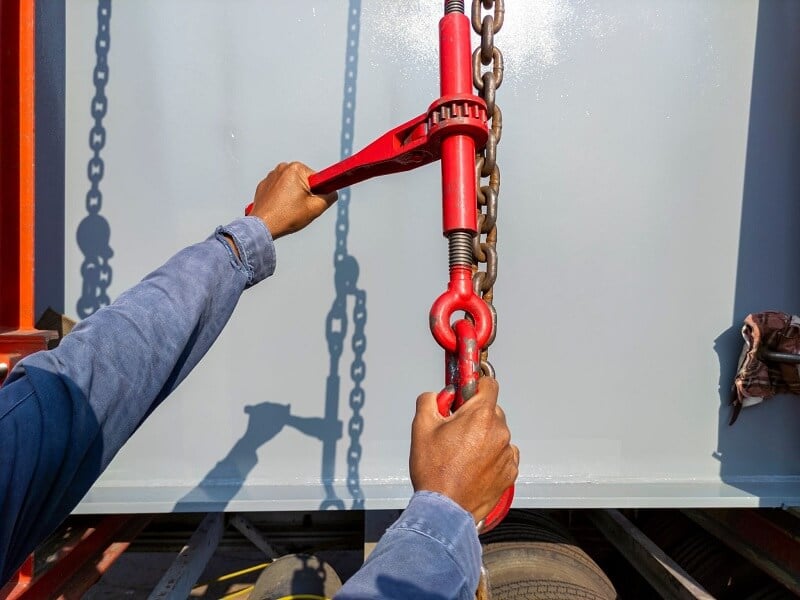Choosing the right tie-down equipment for your cargo can be a stressful or confusing process for most new flatbed haulers. When it comes to tie-down chains, there’s a whole new set of rules and regulations you need to follow to avoid being fined for improperly securing your cargo.
What’s likely the most confusing aspect of cargo chains are their grade ratings and what they mean. At Mytee Products, we’ve crafted an ultimate Cargo Chain Grade Guide to help break it down for you! We’ll go into detail about the types of chain grades, chain ratings, and chain strength as well as what it all means for you!

There are a few very common misunderstandings that people make when trying to find and purchase a chain grade for their load tie-down. Knowing these common mistakes will help ensure that you can avoid making them! According to fellow truckers and chain manufacturers, there are two very common problems flatbed haulers encounter in the industry:
- Using a hoist load chain for lifting.
- Misusing or abusing alloy chains.

Load chains are constructed differently from alloy chains, which are what chain grades 80+ are crafted from. Load chains are specifically used within the inner workings of a hoist, which means that they don’t meet the same strength requirements nor hardness requirements that you might find with a Grade 80 or Grade 100 chain rating. If you mistakenly try to use a load chain for overhead lifting, you risk deforming if not completely snapping the chain, which can cause damage to the chain, the hoist, and your load! Load chains are not graded or prepped for the stress that overhead lifting can cause on-chain ratings over 80+ or made with alloy steel.
The second most common mistake is the general misuse or abuse of alloy chains. This could include improperly storing the chains, infrequent or absent inspection of the chains for damages or wear and tear, and frequent overloading or improper use of the tow chain rating. Frequent inspections are the best way to ensure all your trucking tools and supplies are safe to use. Poorly stored or non-inspected equipment can increase the chances of injury or damage while you’re on the road. Additionally, you should NEVER try to haul or lift cargo that is heavier than the total working load limit of all your chains. Even if you’re using the best, heavy-duty G100 chain, hauling a load heavier than the set load limit of the chain increases your risk of severely damaging your chains and cargo.
How do you calculate a chain grade?
With several different ratings, you may be wondering: How do you calculate chain grades? A chain grade’s number or rating refers to the maximum stress it can handle per millimeter squared. If you were to make it a mathematical equation, it would look similar to the following:
Chain Grade = Maximum Tensile Force (Newtons)/Link Cross-Sectional Area (millimeters)2
Breaking down tow chain ratings using this equation, you could discover that a G70 chain can endure 700 Newtons per millimeter squared before bending, disfiguring, or breaking. Remember, the higher the grade, the higher the tensile strength is compared to the size of the chain links.
This equation works for nearly every chain on the chain chart until you get to chains that are designed with different materials. Carbon steel chains, like Grade 30, 43, and 70, cannot handle the stress/Newtons required for tasks such as overhead lifting. Meanwhile, alloy steel chains – like Grade 80 and higher – can handle that kind of tensile force and thus are recommended for any heavy-duty lifting.
Grade Types and Uses

Grade 30
As shown in the chain strength chart above, chain grade 30 has the smallest amount of strength on the market. That said, their low-stress limit actually makes them ideal for general-purpose, economical uses. Perfect for light construction, agriculture, or marine and household applications like swing sets or guard railers. Grade 30 chains are composed of malleable, rust-resistant carbon steel and have a working load limit between 1,300 to 6,900 lbs depending on the size of the link. While they may not be as strong as alloy chains, G30 chains are the least expensive option for your light construction or agricultural job.
Grade 43
Chain Grade 43 are more durable and stronger than chain grade 30 ratings, making them perfect for more demanding jobs like logging, farming, towing, or as a general-purpose utility chain in trucking. Though stronger than G30, these tow chain ratings are still not recommended for overhead lifting jobs and have a working load limit of 2,600 to 13,000 lbs.
Grade 70
Grade 70 Chain may be the most common tow chain rating you will find in the flatbed hauling industry. Usually coated in a yellow chrome finish, the G70 chain has a load rating roughly 20% higher than Grade 43 making it the strongest carbon steel chain available! Perfect for tying down heavy loads and for tough towing jobs, their unique gold coating makes them DOT recognizable and provides protection from abrasion which then increases their on-the-road lifespan.
Uncute Grade Chain 70 has a working load limit between 3,150 to 15,800 lbs. They’re typically used by truckers and loggers for load securement and towing jobs, and have thus earned the nicknames of Transport and Trucker chain!
Also Read: Important Tips on Grade 70 Chain Usage
Grade 80
The first chain on our chain number chart to be made of alloy steel chain, Grade 80 chain is the first suitable chain to be used as a sling for overhead lifting and heavy-duty towing. The unique alloy material makes this chain’s strength incredibly high, carrying a working load limit of 3,500 to 18,100 lbs! Additionally, you will often hear this chain be referred to as the Alloy Chain, and it’s recognizable by the sleek, black coat finish.
Grade 100
About 25% stronger than the chain rating 80, the chain Grade 100 is the strongest chain on most chain suppliers’ markets. G100 is made of similar strong, alloy steel and can be used in a variety of jobs and industries including overhead lifting slings, construction, manufacturing, and rigging! Based on the size of the links, G100 chains have working load limits of 4,300 to 22,600 lbs. It’s the absolute best choice for extremely heavy-duty lifting or towing jobs.
Grade 120
Still pretty new to the trucking scene, chain grade 120 is the strongest possible chain you can buy. 50% stronger than Grade 80 and 20% strong than Grade 100, G120 chains are the most distinguishable chain because of its unique design and style – it has a bright, blue-coat finish and rectangular links! Grade 120 chains have a working load limit of 5,200 to 27,500 lbs, and are built to fit the most rigorous job requirements.
Determining Chain Working Load Limits

Other safety measures that were put into place when identifying which chains are appropriate and safe for overhead lifting was determining the working load limit of each chain grade. The working load limit of a chain differs depending on the size of the links, as seen in the chain number chart above. It’s integral that you know the total weight of the cargo you plan to haul or lift before you purchase any chain rating.
The chain’s working load limit does not have to match the weight of the load, it only needs to be able to handle the stress and tension when applied – this is based on the surface that is being moved plus the weight of the load. Similar to when people ask how to identify chain grades, determining the working load limit of chain grades can be determined with a formula!
WLL = Minimum Breaking Load (MBL)/Safety Factor (SF)
The working load limit of a chain is significantly less than the weight that would cause a chain to fail (the tensile strength of a chain). A safety factor is a ratio between allowable stress and actual stress that the chain can withstand – the ratio between the chain strength and the expected maximum stress! When it comes to lifting and securement, factors like gravity and additional force – like sharp angles – should also be considered. It’s better to be safer than sorry, so spending a little more money on extra chains or a higher chain grade to ensure your chain limit isn’t less than your cargo’s weight can make all the difference! No matter what, always adhere to the WLL of a chain to ensure it doesn’t break or wear down fast.
Determining Chain Grades
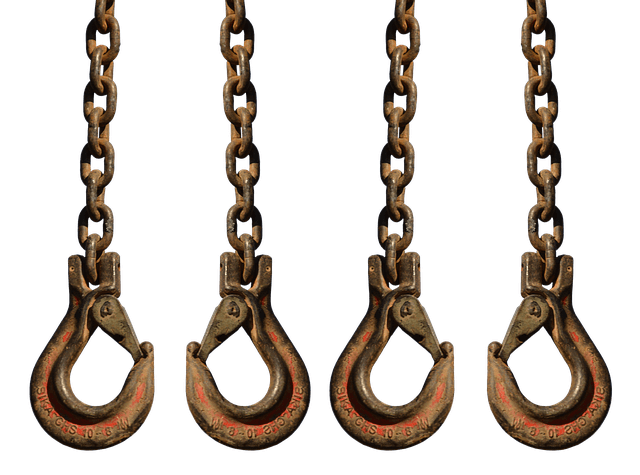
One of the biggest questions chain manufacturers have to answer is how to identify a chain grade efficiently and quickly. When determining which grade to give a chain, the biggest safety measure implemented was finding the ultimate breaking strength of the chain! Remember, chain grades are determined by calculating the newtons of stress per millimeter squared (N/mm2). So, when determining a chain grade, reliable manufacturers will find the chain’s ultimate breaking strength and divide the number by .224805 to then find the chain grade.
Safety Standards for Chains
Regardless of the material a chain is made of or the strength it is determined to handle, all chain ratings must adhere to the NACAM (National Association of Chain Manufacturers) safety standards:
- Chain lifted loads should never be transported or suspended over people.
- All chains should be periodically inspected for cracks, wear, disfigurement, nicks, or overall damage.
- Excessive temperatures or chemical exposure can reduce a chain’s performance; avoid these scenarios or frequently check and replace chains when necessary.
- If the thickness at any location of a link is less than the listed minimum value, all chains should be removed from service.
- When mixing chain or component types, all should be rated at the working load limit of the lowest-rated component or chain.
While these aren’t all the standards required for chain manufacturers to meet, they are some of the most important. Should a manufacturer fail to meet these standards, there is a good chance their chains will fail on the road – and failure on the road can lead to injury, cargo damage, or worse! Always make sure you are purchasing the best chains from the best, most reliable manufacturers.
OSHA and ASTM Standards

Once you’ve found the set of chains best suited for your hauling jobs, it is up to you to ensure you are following the OSHA and ASTM Standards for Chain Grades as well. One very important rule you will continue to hear repeated is that overhead lifting should only be administered with the proper type and proper amount of alloy chain slings – never try to lift or haul cargo that exceeds the weight of your combined alloy steel chain strength.
It’s also important to follow all ASME B30 specifications which regard proper components – such as hooks, coupling links, and other rigging equipment – and outlines several approved sling tools. Selecting the proper chain and rigging configuration to get the job done can be challenging and a bit overwhelming, so always address a chain rigging supplier to ensure that you are following all current OSHA and ASTM guidelines.
While there is a massive variety of chain grades on the market and important differences in chain strengths, materials, and uses, we hope that this article will help you navigate the world of cargo chain ratings. Safety standards for tow chain ratings are constantly changing and evolving, so having a good amount of knowledge regarding chain grades and their working load limits allows you to make an informed decision and purchase when choosing the right chains for your cargo.




